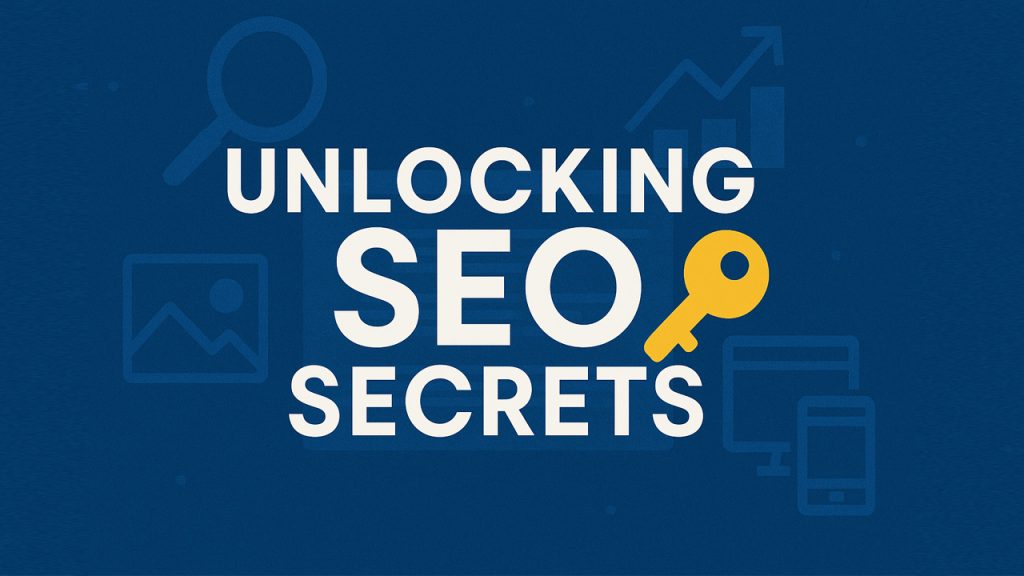
Unlocking SEO Secrets
How to Optimize Content, Media & Mobile for Higher Rankings
SEO. Three little letters that cause big headaches for many small business owners and marketers. But what exactly is SEO, and why does it feel like unlocking some kind of hidden magic trick to rank higher on Google? SEO isn't something new. While there are some new techniques, many of the strategies we've used for years still work really well. I've been utilizing SEO principles on the websites I build for nearly 30 years now.
Today, we're pulling back the curtain. Let's demystify SEO and uncover practical, easy-to-understand secrets you can start applying right away to boost your website's visibility.
First Things First: What Exactly is SEO?
SEO stands for Search Engine Optimization. Simply put, it's about making your website friendlier for search engines like Google, Bing, and Yahoo. The goal? To rank higher on search results pages, driving more organic (free!) traffic to your website.
Here’s an eye-opening statistic to get you started:
"75% of users never scroll past the first page of search results." – HubSpot
That means if your website isn’t on the first page, you're missing a massive chunk of potential visitors—and customers.
The Basics Still Matter
Before diving into specifics, let's quickly revisit the core basics of SEO:
- Quality Content:Valuable, helpful content keeps visitors coming back and signals to search engines that your website deserves attention. Relevant content is the key here. Making sure you have content that relates to the keyword usage is important
- Keywords: Think about the words and phrases your customers use when searching for your products or services. Weave these naturally into your content. You can actually get penalized for keyword stuffing. Meaning over using the keyword in repetition.
- Speed and Performance:Your website should load quickly. Google loves fast websites (and so do visitors). I use the web site https://gtmetrix.com that explains why and where my site is slow. Maybe I’ll cover this in depth in a future article.
Mobile-Friendliness Isn’t Optional Anymore
 Did you know?
Did you know?
"61% of Google searches are performed on mobile devices." – Statista
Because most web traffic now comes from smartphones and tablets, having a mobile-friendly website is absolutely crucial. When your website isn’t optimized for mobile, visitors often face issues like unreadable text, slow loading pages, and difficult navigation, leading them to quickly leave your site. Google's indexing system now favors mobile-friendly sites because it wants to deliver the best user experience possible.
Essentially, if your site performs well on mobile devices, Google sees this as a positive signal, boosting your chances of ranking higher in search results. Making your site mobile-friendly isn't just a nice-to-have feature anymore—it's essential for staying competitive and visible online.
To boost mobile SEO:
- Use responsive design, which means your website layout automatically adjusts to fit screens of all sizes, from desktops to smartphones.
- Ensure fast mobile load times. Utilizing optimized image sizes helps here too.
- Make buttons and links easily tappable. Make sure they’re not too close together. Not only is this good visually but also is something that helps American Disabilities Act (ADA) compliance.
- Simplify navigation for smaller screens. Many times you’ll see the use of the Hamburger menu (the tree lines) to simplify menu space usage.
SEO Secret Weapon: Images, Videos, and PDFs
Did you know your images, videos, and PDFs can greatly improve your SEO? Most people overlook these valuable elements, but they're powerful tools for boosting your site's visibility. Each type of content offers a unique opportunity to enhance your ranking potential.
Images attract visitors through visual search results, videos can significantly increase user engagement, and PDFs often hold detailed content that users seek out and download. By optimizing these media files—using descriptive, keyword-rich file names, appropriate alt tags, comprehensive descriptions, and clear titles—you not only help search engines better understand your content but also provide a richer user experience, leading to higher rankings and increased traffic.
Images & SEO
The file names and alt tags of your images matter more than you might realize. Naming an image file something descriptive like red-tennis-shoes.jpg instead of IMG_9384.jpg helps Google understand exactly what's in the image. This makes your image searchable on Google Images, driving more traffic back to your site.
Alt Tags are Your Best Friends
Alt tags, short for "alternative text," are brief descriptions attached to images. They serve two major purposes:
- They help visually impaired users understand images.
- They tell search engines exactly what the image depicts.
Here's a quick tip:
- Bad Alt Tag: Shoes
- Good Alt Tag: Men's red tennis shoes size 10
Use your primary keyword in alt tags naturally to enhance visibility.
Videos & SEO
Video content is booming. According to Cisco:
"By 2024, video will account for 82% of all online traffic."
Just like images, how you name your video files before uploading matters. A video titled How-to-fix-leaky-faucet.mp4 gives search engines clear context versus something vague like video123.mp4.
Remember to add descriptions to your videos, too, as search engines index this text.
Don’t Forget About PDFs
PDF documents on your site can also contribute positively to your SEO. Make sure PDFs are:
- Properly named (e.g., 2025-product-catalog.pdf instead of catalogfinal.pdf).
- Optimized with descriptive, keyword-rich titles and meta descriptions within the document properties.
- Linked internally within your website to improve discoverability.
Meta Descriptions: Your Website’s Front Door
While meta descriptions don't directly affect rankings, they significantly impact click-through rates from search results. This brief snippet (about 160 characters) tells users exactly what they'll get when they click on your page.
A compelling meta description can drastically increase visits, indirectly boosting your rankings by signaling Google that your content is valuable. I’ve read where some people will argue that this strategy is no longer needed, I still find it beneficial and every little bit helps.
Internal Linking: Connect the Dots
Think of internal links as pathways guiding visitors and search engines through your website. They help:
- Users easily find related content.
- Search engines crawl your site better, boosting your overall ranking potential.
Strategically link related pages using descriptive anchor text. Here's a quick example to illustrate:
- Link Text: Click here for our latest SEO guide.
- Anchor Text: latest SEO guide
- URL Text (file name): seo-guide-2025.pdf
By clearly describing your link, you give visitors and search engines valuable context, enhancing user experience and SEO effectiveness. Additionally, using descriptive anchor text greatly aids visitors using screen readers, enhancing accessibility and ensuring ADA compliance. Clearly labeled links help these users navigate your content more easily and effectively.
Security and HTTPS
Google explicitly prefers secure websites. Having HTTPS (instead of HTTP) means your site is encrypted and safer for visitors. Plus, it boosts your credibility, reassuring visitors their data is safe. The easiest way to see if your website has https is look for the padlock icon in your browser's address bar.
If your site still isn’t HTTPS, switch now—it’s usually free and easy with most web hosting providers. You will also want to check with your webmaster or hosting agent to implement the option to force https. This simply means if the URL wasn’t typed with https it will force it to be so.
Tracking Your Success
Use tools like Google Analytics and Google Search Console to track your performance. These powerful, free tools provide insights into which keywords drive traffic, how long users stay on your pages, and where improvements can be made. Your website hosting may have AWStats as part of its hosting panel. This provides some really good tracking information as well.
Final Thoughts: SEO is Ongoing, Not a One-Time Event
SEO isn’t "set it and forget it." Regularly update your content, review your mobile performance, check your image and video optimization, and keep track of your progress. If you think of these strategies as you add new content you will save yourself a lot of time and headache. If you’re site is built on WordPress there are SEO tools such as RankMath that make the task even easier.
SEO success comes with consistency, patience, and continual fine-tuning.
There you have it! The secrets of SEO aren't as hidden or scary as they might seem. By applying these straightforward strategies, you'll soon notice your website climbing up the rankings and reaching more customers.
Keep making your website better every day.
Need help improving your website contact me today.
Frank Deardurff
That One Web Guy
